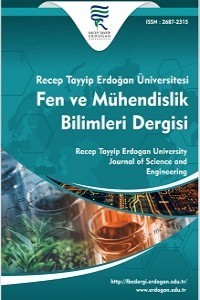Effect of Damping Ratios on the Seismic Behavior of a Historical Masonry Guesthouse Building
The dynamic parameters obtained depending on the existing structural properties, material properties, boundary and damage condition are quite effective on the behavior of the structures under the effect of dynamic loads. These dynamic parameters have characteristic features for each structure. In this study, the effect of damping ratio, which is one of the dynamic characteristics, on the seismic behavior of historical structures was studied. For this aim, historical masonry Guesthouse Building belong to the Church of Santa Maria was selected to examined. Linear time history analyses were performed for three different damping ratios as 2%, 5%, and 10%. The horizontal component of Erzincan Earthquake (1992) was used in linear time history analyses. The maximum displacement, principal stress and strain values obtained from performed linear time history analyses for different damping ratios were compared. It is observed that, displacement, stress and strain values increase as the damping ratio decrease when the results are examined. It is concluded that, damping ratio is the important parameter for the evaluation of seismic response of historical masonry structures which are weak to external effect especially earthquake. Therefore, the damping ratios should be obtained with experimental tests before the numerical evaluation of seismic behavior.
Anahtar Kelimeler:
Damping ratios, Historical masonry structures, Finite element method, Seismic analysis
Effect of Damping Ratios on the Seismic Behavior of a Historical Masonry Guesthouse Building
The dynamic parameters obtained depending on the existing structural properties, material properties, boundary and damage condition are quite effective on the behavior of the structures under the effect of dynamic loads. These dynamic parameters have characteristic features for each structure. In this study, the effect of damping ratio, which is one of the dynamic characteristics, on the seismic behavior of historical structures was studied. For this aim, historical masonry Guesthouse Building belong to the Church of Santa Maria was selected to examined. Linear time history analyses were performed for three different damping ratios as 2%, 5%, and 10%. The horizontal component of Erzincan Earthquake (1992) was used in linear time history analyses. The maximum displacement, principal stress and strain values obtained from performed linear time history analyses for different damping ratios were compared. It is observed that, displacement, stress and strain values increase as the damping ratio decrease when the results are examined. It is concluded that, damping ratio is the important parameter for the evaluation of seismic response of historical masonry structures which are weak to external effect especially earthquake. Therefore, the damping ratios should be obtained with experimental tests before the numerical evaluation of seismic behavior.
___
- Abaqus (2016). Dassault systémes simulia corp. Providence: Rhode Island, USA.
- Altunışık, A.C., Adanur, S., Genç, A.F., Günaydın, M. and Okur, F.Y. (2017). An investigation of the seismic behavior of an ancient masonry bastion using non-destructive and numerical methods, Experimental Mechanics, 57, 2, 245-259.
- Altunışık, A.C., Adanur, S., Genç, A.F., Günaydın, M. and Okur, F.Y. (2016). Non-destructive testing of an ancient masonry bastion, Journal of Cultural Heritage, 22, 1049-1054.
- Altunışık, A.C., Genç, A.F., Günaydin, M., Adanur, S. and Okur, F.Y. (2018). Ambient vibration-based system ıdentification of a medieval masonry bastion for health assessment using nonlinear analyses, International Journal of Nonlinear Sciences & Numerical Simulation, 19, 2, 107-124.
- Benedetti, D., Carydis, P. and Pezzoli, P. (1998). Shaking table tests on 24 simple masonry buildings, Earthquake Engineering and Structural Dynamics, 27, 1, 67-90.
- Gentile, C. and Saisi, A. (2007). Ambient vibration testing of historic masonry towers for structural identification and damage assessment, Construction and Building Materials, 21, 6, 1311-1321.
- Juhásová, E., Sofronie, R. and Bairrão, R. (2008). Stone masonry in historical buildings-ways to increase their resistance and durability, Engineering Structures, 30, 8, 2194-2205.
- Mazzon, N, Valluzzi, M.R., Aoki, T., Garbin, E., De Canio, G., Ranieri, N. and Modena, C. (2009). Shaking table tests on two multi-leaf stone masonry buildings, In: Proceeding of 11th Canadian Masonry Symposium, May 31st - June 3rd, Toronto, Canada.
- Toker, S. and Ünay, A.İ. (2004) Mathematical modeling and finite element analysis of masonry arch bridges, Gazi University Journal of Science, 17, 2, 129-139.
- Votsis, R.A., Kyriakides, N., Chrysostomou, C.Z., Tantele, E. and Demetriou, T. (2012). Ambient vibration testing of two masonry monuments in Cyprus, Soil Dynamics and Earthquake Engineering, 43, 58-68.
- ISSN: 2687-2315
- Yayın Aralığı: Yılda 2 Sayı
- Başlangıç: 2020
- Yayıncı: Ertuğrul Ağırbaş
Sayıdaki Diğer Makaleler
An Overview of Flyrock and its Prediction in Surface Mine Blasting using Soft Computing Techniques
Vineeth BALAKRİSHNAN, Piyush RAİ
Harun ŞEN, Ayşe Pınar MERT CÜCE, Erdem CÜCE
Vincetoxicum tmoleum Boiss. Taksonunun Genişletilmiş Morfolojik Özellikleri ve Türkiye’deki Yayılışı
Seher GÜVEN, Serdar MAKBUL, Kamil COŞKUNÇELEBİ
Mehmet ŞİMŞEK, Haydar KÜÇÜK, Adnan MİDİLLİ
Hatice Kübra DÜZEL, Birsen ÇAKIR AYDEMİR
Akaryakıt İmar Adalarında Mesafe Yaklaşımına Göre İmar Çapı Gösterimi
Effect of Damping Ratios on the Seismic Behavior of a Historical Masonry Guesthouse Building
Ali Fuat GENÇ, Esin ERTÜRK, Ahmet Can ALTUNIŞIK, Murat GÜNAYDIN, Fatih Yesevi OKUR
